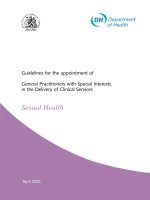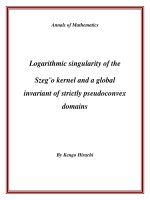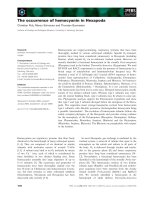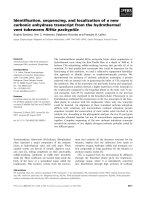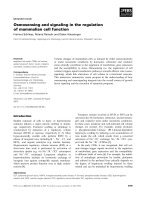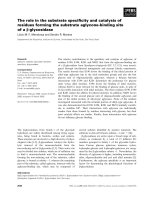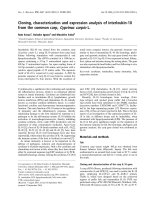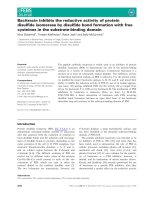Antibody-mediated delivery of IL-10 inhibits the progression of established collagen-induced arthritis docx
Bạn đang xem bản rút gọn của tài liệu. Xem và tải ngay bản đầy đủ của tài liệu tại đây (1.04 MB, 9 trang )
Open Access
Available online />Page 1 of 9
(page number not for citation purposes)
Vol 9 No 1
Research article
Antibody-mediated delivery of IL-10 inhibits the progression of
established collagen-induced arthritis
Eveline Trachsel
1
, Frank Bootz
1
, Michela Silacci
1
, Manuela Kaspar
1
, Hartwig Kosmehl
2
and
Dario Neri
1
1
Institute of Pharmaceutical Sciences, Department of Chemistry and Applied Biosciences, ETH Zurich, Wolfgang-Paulistrasse 10, CH-8093 Zurich,
Switzerland
2
Institute of Pathology, Helios Klinikum Erfurt, Nordhaeuser Strasse 74, D-99089 Erfurt, Germany
Corresponding author: Dario Neri,
Received: 12 Oct 2006 Revisions requested: 6 Dec 2006 Revisions received: 12 Jan 2007 Accepted: 29 Jan 2007 Published: 29 Jan 2007
Arthritis Research & Therapy 2007, 9:R9 (doi:10.1186/ar2115)
This article is online at: />© 2007 Trachsel et al.; licensee BioMed Central Ltd.
This is an open access article distributed under the terms of the Creative Commons Attribution License ( />),
which permits unrestricted use, distribution, and reproduction in any medium, provided the original work is properly cited.
Abstract
The antibody-mediated targeted delivery of cytokines to sites of
disease is a promising avenue for cancer therapy, but it is largely
unexplored for the treatment of chronic inflammatory conditions.
Using both radioactive and fluorescent techniques, the human
monoclonal antibodies L19 and G11 (specific to two markers of
angiogenesis that are virtually undetectable in normal adult
tissues) were found to selectively localize at arthritic sites in the
murine collagen-induced model of rheumatoid arthritis following
intravenous (i.v.) administration. The same animal model was
used to study the therapeutic action of the L19 antibody fused
to the cytokines IL-2, tumour necrosis factor (TNF) and IL-10.
Whereas L19–IL-2 and L19–TNF treatment led to increased
arthritic scores and paw swellings, the fusion protein L19–IL-10
displayed a therapeutic activity, which was superior to the
activity of IL-10 fused to an antibody of irrelevant specificity in
the mouse. The anti-inflammatory cytokine IL-10 has been
investigated for the treatment of patients with rheumatoid
arthritis, but clinical development plans have been discontinued
because of a lack of efficacy. Because the antigen recognised
by L19 is strongly expressed at sites of arthritis in humans and
identical in both mice and humans, it suggests that the fusion
protein L19–IL-10 might help overcome some of the clinical
limitations of IL-10 and provide a therapeutic benefit to patients
with chronic inflammatory disorders, including arthritis.
Introduction
The therapeutic potential of recombinant cytokines is often
limited by severe toxicities, even at low doses, thus preventing
dose escalation and the establishment of a sufficient concen-
tration at target tissues. In principle, monoclonal antibodies
could be used to deliver cytokines to sites of disease, thus
increasing their potency and sparing normal tissues. Indeed,
several antibody–cytokine fusion proteins have been investi-
gated for cancer therapy applications, often with impressive
therapeutic results [1-4].
Components of the modified extracellular matrix (ECM) are
particularly attractive for antibody-based targeting applica-
tions, because these antigens are often stable and abundant
[5]. In the past, our group has focused its efforts on the devel-
opment of human monoclonal antibodies, which recognise
ECM components that are virtually absent in normal tissues
but strongly expressed at sites of disease and have a promi-
nent perivascular pattern of expression [6]. Splice isoforms of
abundant ECM components seem to be particularly suited for
antibody-mediated in vivo targeting applications. For example,
the extra domai [7-10] and C domain of tenascin-C [11-13]
are two of the most promising markers of angiogenesis, which
can be targeted using the high-affinity monoclonal antibodies
L19 and G11, respectively [14-19]. Several derivatives of the
L19 antibody have exhibited impressive therapeutic activity in
animal models of cancer [1,2,4,20-24] and angiogenesis-
related ocular disorders [25]. In particular, the antibody–
CIA = collagen-induced arthritis; ECM = extracellular matrix; EDB = extra domain B of fibronectin; ELISA = enzyme-linked immunosorbent assay;
FPLC = fast performance liquid chromatography; IFN = interferon; Ig = immunoglobulin; IL = interleukin; i.v. = intravenous; MRI = magnetic resonance
imaging; MTT = thiazole blue; PCR = polymerase chain reaction; scFv = single chain variable fragment; SEM = standard error of the mean; SIP =
small immunoprotein; TNF = tumour necrosis factor.
Arthritis Research & Therapy Vol 9 No 1 Trachsel et al.
Page 2 of 9
(page number not for citation purposes)
cytokine fusions L19–IL-2 and L19–tumour necrosis factor
(TNF) and the radiolabelled antibody SIP(L19) (SIP, small
immunoprotein) are currently in clinical development [26,27].
The antibody-mediated targeted delivery of cytokines is largely
unexplored in arthritis and other chronic inflammatory dis-
eases. Although it is well established that pro-inflammatory
cytokines (such as TNF and IL-1) can have a negative effect on
arthritis [28,29], anti-inflammatory cytokines might provide a
therapeutic benefit. For example, IL-10 has been shown in a
collagen-induced arthritis (CIA) mouse model to inhibit paw
swelling and an increase in arthritic score [30-33]. Recom-
binant IL-10 was found to synergize with TNF-blocking anti-
bodies [33] and has been tested in clinical trials in
combination with methotrexate [34,35]. The clinical develop-
ment of recombinant human IL-10 was discontinued because
of a lack of efficacy of the compound in humans.
In this article, we show that both L19 and G11 antibodies dis-
play an impressive ability to selectively localize at sites of
arthritis in the CIA mouse model. Furthermore, whereas L19–
IL-2 and L19–TNF treatment led to increased arthritic scores
and paw swelling compared with controls, the fusion protein
L19–IL-10 displayed therapeutic activity, which was superior
to the activity of IL-10 fused to an antibody of irrelevant specif-
icity in the mouse. These findings might be of clinical signifi-
cance because EDB has an identical sequence in humans and
mice [7,36], is virtually absent in normal adult tissues [37] and
is strongly expressed at arthritic sites in patients [38-40].
Materials and methods
Animal model
Male DBA/1 mice (8–12 weeks' old) were immunized by intra-
dermal injection at the base of the tail with 200 μg of bovine
type II collagen (MD Biosciences, Egg, Zurich, Switzerland)
emulsified with equal volumes of Freund's complete adjuvant
(MD Biosciences). The procedure was repeated 2 weeks after
the first immunization, but incomplete Freund's adjuvant (MD
Biosciences) was used to emulsify the collagen in the second
procedure. Mice were inspected daily and each mouse that
exhibited erythema and/or paw swelling in one or more limbs
was assigned to an imaging or treatment study.
Arthritis was monitored using two disease indices (clinical
score and paw swelling). For the clinical score, each limb was
graded daily in a nonblinded fashion (0 = normal, 1 = swelling
of one or more fingers of the same limb and 2 = swelling of the
whole paw), with a maximum possible score of 8 per animal.
Paw swelling was assessed every second day using a calliper
to measure the thickness of each limb under isoflurane anaes-
thesia. The paw thickness of each animal was expressed as
the mean value of all four paws.
Immunohistochemical analysis
Frozen sections of arthritic paws were fixed in ice-cold ace-
tone and stained for EDB. For immunohistochemical analysis,
the L19 antibody was used in the miniantibody format
(SIP(L19)). As secondary detection antibodies, we used rab-
bit antihuman immunoglobulin (Ig) E (Dako, Golstrup, Den-
mark) followed by biotinylated antirabbit IgG (Biospa, Milan,
Italy) and streptavidin–alkaline phosphatase complex
(Biospa). Fast red TRsalt (Sigma, Saint Louis, Missouri, USA)
was used to develop the staining. Slides were counterstained
with haematoxylin, mounted with Glycergel
®
mounting
medium (Dako) and analysed with a Zeiss Axiovert S100 TV
microscope (Feldbach, Switzerland).
For immunofluorescence, a double staining for EDB and
CD31 was performed. The following primary antibodies were
used: SIP(L19) and rat antimouse CD31 (BD Pharmingen,
Erembodegen, Belgium). As secondary detection antibodies,
we used rabbit antihuman IgE (Dako), followed by Alexa Fluor
594 goat antirabbit IgG (Molecular Probes, Leiden, The Neth-
erlands) for EDB and Alexa Fluor 488 goat antirat IgG (Molec-
ular Probes) for CD31. Slides were mounted and analysed, as
described above.
Near-infrared imaging of arthritic paws
The selective accumulation of SIP(L19) and SIP(G11) in
arthritic mice was tested by near-infrared imaging analysis, as
described by Birchler and colleagues [41]. Briefly, purified
SIP(L19), SIP(G11) and SIP(HyHEL10) were labelled using
Alexa750 (Molecular Probes), according to the manufacturer's
recommendations, and injected into the tail vein of arthritic
mice. Mice were anaesthetized using ketamine, 80 mg/kg
body weight, and medetomidine, 0.2 mg/kg body weight, and
imaged in a near-infrared mouse imager 24 hours after injec-
tion [41].
Biodistribution experiments
The in vivo targeting performance of SIP(L19) in arthritic mice
was evaluated by biodistribution analysis, as described previ-
ously [14,17]. Briefly, purified SIP(L19), SIP(G11) and
SIP(F16) were radio-iodinated and injected into the tail vein of
arthritic mice (5 μg corresponding to 12 μCi SIP(L19), 5 μg
corresponding to 10 μCi SIP(G11) and 5 μg corresponding
to 11 μCi SIP(F16) per mouse). Mice were sacrificed 24 hours
after injection and their paws were exposed to a phosphorim-
ager screen (Fujifilm, Dielsdorf, Switzerland) for 1 hour and
read in a PhosphorImager (Fujifilm BAS-5000).
Cloning of L19–IL-10 and HyHEL10–IL-10
The human IL-10 gene was amplified from a commercial cDNA
panel (Clontech, Basel, Switzerland) by PCR using the follow-
ing primer sequences: a backward antisense primer, 5'-
AGCCCAGGCCAGGGCA-CCCAGTCTG-3'; and a forward
sense primer, 5'-GTTTCGTATCTTCATT-GTCATGTAGGCT-
TCTATG-TAGTTGATGAAGATG-3'. The resulting fragment
Available online />Page 3 of 9
(page number not for citation purposes)
was then further amplified using the following primer
sequences: a backward antisense primer, 5'-
TCGGGTAGTAGCTCTTCCGGCTCATCGTCCAGCG-
GCAGCCCAGGC-CAGGGCACC-3'; and a forward sense
primer, 5'-TAATGGTGATGGTGATGGTGGTTTCGTATCT-
TCATT-GTCATGTAGGCTTC-3', which appended part of a
15 amino acid linker (SSSSG)
3
at its N-terminal and a His
6
tag,
stop codon and NotI restriction site at its C-terminal.
The genes for the single-chain variable fragments (L19) and
(HyHel10) were coamplified with a signal peptide using the
following primer pairs, respectively: a backward antisense
primer, 5'-CCCAAGCTTGTCGACCATGGGCTGGAGCC-
3' and a forward sense primer, 5'-GAGCCGGAAGAGCTA
CTACCCGATGAGGAAGATTTGATTTCCACCTTGGTCC
CTTG-3'; and a backward antisense primer, 5'-CCCAAGCTT-
GTCGACCATGGGCTGGAGCC-3' and a forward sense
primer, 5'-GAGCCGGAA-GAGCTACTACCCGATGAGGA
AGATTTTATTTCCAGCTTGGTCCCC-3'. Using this strat-
egy, a HindIII restriction site was inserted at the N-terminal and
a complementary part of the linker sequence was inserted at
the C-terminal.
The single-chain Fv and IL-10 fragments were then assembled
using PCR and cloned into the HindIII and NotI restriction
sites of the mammalian cell-expression vector pcDNA3.1(+)
(Invitrogen, Basel, Switzerland).
Expression and purification of L19–IL-10 and HyHEL10–
IL-10
HEK293 cells were stably transfected with the previously
described plasmids and selection was carried out in the pres-
ence of G418 (0.5 g/l). Clones of G418-resistant cells were
screened for expression of the fusion protein by ELISA using
a recombinant EDB of human fibronectin or lysozyme as anti-
gens and an anti-His
6
-tagged antibody (Sigma) for detection.
The fusion proteins were purified from the cell-culture medium
by affinity chromatography over antigen columns, as described
previously [17,42]. The size of the fusion proteins was ana-
lysed in reducing and nonreducing conditions on SDS-PAGE
and in native conditions by FPLC gel filtration on a Superdex
S-200 exclusion column (Amersham Pharmacia Biotech,
Dübendorf, Switzerland).
The in vivo targeting performance of L19–IL-10 in tumour-
bearing mice was evaluated by biodistribution analysis, as
described previously [14,17]. Briefly, purified L19–IL-10 was
radio-iodinated and injected into the tail vein of female 129Sv
mice grafted with a subcutaneous F9 tumour (3 μg corre-
sponding to 4 μCi L19–IL-10 per mouse). Mice were sacri-
ficed 24 hours after injection; the tumours and organs were
weighed and counted.
Biological activity of human IL-10 was determined by its ability
to induce the IL-4-dependent proliferation of MC/9 cells [43]
using a colourimetric thiazole blue (MTT) dye-reduction assay
(Sigma). In a 96-well microtitre plate, 10,000 MC/9 (murine
mast cell line) (ATCC-LCG, Molesheim Cedex, France) cells/
well in 200 μl of medium containing 5 pg (0.05 units)/ml of
murine IL-4 (eBiosciences, San Diego, CA, USA) were treated
for 48 hours with varying amounts of human IL-10. The human
IL-10 standard and fusion proteins were used at a maximum
concentration of 100 ng/ml IL-10 equivalents and serially
diluted. To this, 10 μl of 5 mg/ml MTT was added and the cells
were incubated for 3–5 hours. The cells were then centri-
fuged, lysed with dimethylsulfoxide (DMSO) and read for
absorbance at 570 nm.
Targeted delivery of cytokines to arthritic lesions
Immunocytokines L19–IL-2 and L19–TNF-α were prepared,
as described previously [1,2]. Each mouse that exhibited ery-
thema and/or swelling of one or more paws was randomly
assigned to a treatment or control group and therapy was
started. Mice were given an i.v. injection in the lateral tail vein
with saline or L19–IL-2, L19–TNF-α or L19–IL-10 diluted in a
volume of 200 μl of saline. The cumulative doses for the fusion
proteins were 60 μg of L19–IL-2, 15 μg of L19–TNF and 450
μg of L19–IL-10 per mouse. The arthritic score was evaluated
daily in a nonblinded fashion. A scoring system was used with
the following scale: 0 = normal, 1 = swelling of single fingers
or toes and 2 = pronounced oedematous swelling of the
whole paw [29]. Swelling of the paws was measured every
second day using a calliper and the paw thickness of each ani-
mal was expressed as the mean score of all four paws. The
results are displayed as the mean ± standard error of the mean
(SEM) for each group; each group contained seven mice.
Experiments were performed in agreement with Swiss regula-
tions and under a project license granted by the Veterinäramt
des Kantons Zürich, Switzerland (180/2004).
Comparison of targeted versus systemic application of
IL-10
Each mouse that exhibited erythema and/or swelling of one or
more paws was randomly assigned to a treatment or control
group and therapy was started. Mice were given an i.v. injec-
tion in the lateral tail vein with saline, L19–IL-10 (3 × 150 μg)
or HyHel-IL-10 (3 × 150 μg). Six mice were analysed per
group. The arthritic score was evaluated daily in a nonblinded
fashion and paw thickness was measured every second day.
Experiments were performed in agreement with Swiss regula-
tions and under a project license granted by the Veterinäramt
des Kantons Zürich (180/2004).
Statistical analysis
Data are expressed as the mean ± SEM. Differences in the
arthritis score between different populations of mice were
compared using a Student t test. P < 0.05 was considered
significant.
Arthritis Research & Therapy Vol 9 No 1 Trachsel et al.
Page 4 of 9
(page number not for citation purposes)
Results
Histochemical analysis of arthritic paws
Expression of EDB-containing fibronectin was investigated by
immunohistochemistry in inflamed paws from arthritic mice
using the L19 antibody. EDB-containing fibronectin was
detected in the tunica synovialis and stroma of inflammatory
infiltrates (Figure 1a,b). Using immunofluorescence methods,
the L19 antibody was furthermore shown to stain CD31-posi-
tive blood vessels (Figure 1c–e).
The human monoclonal antibodies L19 and G11
selectively accumulate at sites of arthritis
We studied the in vivo targeting performance of L19 and G11
in miniantibody format (SIP) [14] in the CIA mouse model
using both fluorescence and radioactivity for antibody detec-
tion. The SIP format consists of a single-chain Fv antibody
fragment linked to the CH4 domain of human IgE, giving rise
to a homodimeric protein of 80 kDa.
Arthritic mice were injected with SIP(L19), SIP(G11) or
SIP(HyHEL10) labelled with the near-infrared dye Alexa750.
Twenty-four hours after i.v. injection, animals were imaged
using an infrared fluorescence imager [41], revealing a strong
and selective antibody accumulation of SIP(L19) and
SIP(G11) in the lesions present in the arthritic limb. By con-
trast, mice injected with SIP(HyHEL10), an antibody of irrele-
vant specificity in the mouse that was used as a negative
control, displayed only a faint fluorescence signal, owing to
nonspecific extravasation of the labelled antibody through the
leaky vessels in the inflamed extremity (Figure 2).
Twenty-four hours after i.v. injection of SIP(L19) and
SIP(G11), which were radiolabelled with iodine (
125
I), the mice
were sacrificed and paws were imaged by autoradiography. A
preferential accumulation of radioactivity was observed in the
inflamed extremities of mice injected with SIP(L19) and
SIP(G11), whereas no preferential antibody accumulation
could be detected in mice exhibiting comparable grades of
inflammation that had been injected with a SIP antibody of
irrelevant specificity in the mouse. Biodistribution analysis per-
formed with radiolabelled antibody preparations have previ-
ously shown that the percentage injected dose of antibodies
in SIP format per gram of tissue typically lies below 1% 24
hours after injection, both for blood and for all major organs
[14]. The ranges of lesion to nonaffected paw ratios measured
by phosphorimaging were 3.3–8.5 for SIP(L19) and 2.0–4.9
for SIP(G11) (Figure 2).
Cloning, expression and characterization of single-chain
Fv–human IL-10 fusion proteins
To investigate the effect of targeted delivery of cytokines to
sites of inflammation, arthritic mice were injected with different
L19–cytokine fusion proteins. The cloning and expression of
the fusion proteins between single-chain Fv fragments of the
L19 antibody (Fv(L19)) and IL-2 or TNF has been described
before [1,2]. To test the therapeutic potential of a targeted ver-
sion of the anti-inflammatory cytokine IL-10, we produced the
fusion protein between single-chain Fv(L19) and IL-10 using a
gene-fusion approach (L19–IL10; Figure 3a,b). In a similar
manner, we produced a fusion protein between the negative-
control antibody single-chain Fv(HyHEL10) [44] and IL-10, to
Figure 1
Histochemical analysis of arthritc paw sectionsHistochemical analysis of arthritc paw sections. Immunohistochemistry with the small immunoprotein L19 on arthritic paw sections reveals expres-
sion of extra domain B of fibronectin (EDB) in the tunica synovialis and inflammatory infiltrates (a) and (b). An immunofluorescent co-staining shows
co-localisation of CD31 (green) and EDB (red) surrounding vascular structures (c)–(e). Scale bars = 100 μm.
Available online />Page 5 of 9
(page number not for citation purposes)
assess the therapeutic performance of proteins with compara-
ble clearance rates but different targeting selectivity.
The human antibody fragments single-chain Fv(L19) and sin-
gle-chain Fv(HyHEL10), preceded by a signal sequence
required for secretion of recombinant proteins, were geneti-
cally fused to human IL-10 with a 15 amino acid linker between
the C-terminal of the single-chain Fv fragment and the N-termi-
nal of human IL-10. A His
6
tag was appended to the C-terminal
of the fusion proteins and the resulting antibody derivatives
were expressed in stably transfected HEK293 cells. L19–IL-
10 and HyHEL10–IL-10 were purified from the culture
medium by affinity chromatography on antigen columns at
yields of 1–2 mg/l. Both fusion proteins migrated at the
expected size of 43 kDa in reducing and nonreducing condi-
tions (Figure 3c). The size-exclusion chromatography profile of
the purified fusion proteins showed a main peak eluting at
13.5 ml, corresponding to the biologically active heterodimer,
and a lower peak eluting at 16 ml, corresponding to the mon-
omer (Figure 3d). The in vivo targeting properties of a radio-
iodinated preparation of L19–IL-10 were evaluated in a biodis-
tribution experiment [17] in 129SvEv mice carrying subcuta-
neous F9 teratocarcinomas [4]. Favourable tumor : organ
ratios (ranging from 7 : 1 to 128 : 1) were observed 24 hours
after i.v. administration (Figure 3e). The biological activity of
human IL-10 was confirmed, by the ability of the two fusion
proteins to induce IL-4-dependent proliferation of MC/9 cells
[43], using the colourimetric MTT dye-reduction assay (data
not shown).
Effect of targeted delivery of cytokines to arthritic
lesions
In a first-therapy experiment, we compared the potential of
L19–IL-10 with L19–IL-2 and L19–TNF, using mice with CIA.
Saline-injected mice were used as a control group. Mice
received three injections every 48 hours, starting on day 1
after the onset of arthritis. The cumulative doses, which were
equal to the doses previously used for tumour therapy
Figure 2
Investigation of the selective accumulation of the small immunoproteins L19 and G11 in inflamed limbs of arthritic miceInvestigation of the selective accumulation of the small immunoproteins L19 and G11 in inflamed limbs of arthritic mice. Arthritic mice were injected
with SIP(L19)–Alexa750 (Molecular Probes, Leiden, The Netherlands), SIP(G11)–Alexa750 or the control antibody SIP(HyHEL10)–Alexa750.
Near-infrared fluorescence imaging analysis was performed 24 hours after injection of the fluorescence-labelled antibodies. Arrows indicate grade 2
swelling in the front paws of the mice. In a similar experiment, arthritic mice were injected with
125
I-labelled SIP(L19), SIP(G11) or SIP control.
Uptake of radio-iodinated antibodies was analysed by phosphorimaging 24 hours after injection. The mouse injected with
125
I-labelled SIP(L19) had
an arthritic score of 2 in the left paw, whereas the right paw was classified as grade 1 arthritis. In the mouse injected with
125
I-labelled SIP(G11) the
left paw was classified as grade 1 arhritis, whereas the right paw was classified as grade 2 arthritis. In the mouse injected with
125
I-labelled SIP(F16)
the left paw was classified as grade 2 arthritis, whereas the right paw as grade 1 arthritis.
Arthritis Research & Therapy Vol 9 No 1 Trachsel et al.
Page 6 of 9
(page number not for citation purposes)
experiments [1,2], were 60 μg of L19–IL-2 and 15 μg of L19–
TNF. Each mouse received a dose of 450 μg of L19–IL-10 in
this experiment and subsequent experiments with antibody–
IL-10 fusion proteins, in line with IL-10 doses previously found
to be active and nontoxic in mice [45].
L19–IL-10 had a clear therapeutic effect on both the arthritic
score and paw swelling (P = 0.026; Figure 4a,b). The magni-
tude of this effect was similar to that observed with TNF-neu-
tralizing antibodies in the same animal model [28,33]. By
contrast, L19–IL-2 and L19–TNF led to a rapid and pro-
nounced swelling of the affected limbs, which was more
severe than the effect reported in the control (saline) group.
None of the treated animals died or exhibited a weight loss of
more than 15%, and arthritic parameters did not significantly
worsen after the third antibody administration (Figure 4a).
Comparison of targeted delivery compared with
systemic application of IL-10
To demonstrate a therapeutic advantage of a targeted version
of IL-10, compared with the untargeted cytokine, the two
fusion proteins L19–IL-10 and HyHEL10–IL-10 were investi-
gated in the CIA model. Similar to the previous experiment,
arthritic mice were treated with three injections of L19–IL-10,
HyHEL10–IL-10 or saline every second day, starting on the
first day of arthritis onset. For both fusion proteins, the
cumulative dose administered to each mouse was 450 μg. As
expected, L19–IL-10 showed a significant therapeutic
response compared with the control (saline) group (P =
0.037), with both the arthritic score and paw swelling remain-
ing low until day 9 after arthritis onset (that is 4 days after the
last injection). Consistent with previous observations of the
therapeutic activity of IL-10 in this model, the nontargeted
Figure 3
Cloning, expression and purification of L19–IL-10 and HyHel10–IL-10Cloning, expression and purification of L19–IL-10 and HyHel10–IL-10. (a) Schematic representation of single-chain variable fragment-IL-10 fusion
proteins. (b) Schematic representation of a pcDNA3.1 vector (Invitrogen Basel, Switzerland) containing the essential elements of the L19–IL-10 or
HyHEL10–IL-10 fusion proteins. The human IL-10 moiety was fused to the C-terminal of the single-chain Fv antibody fragment by the 15 amino acid
linker (SSSSG)
3
. The secretion sequence at the N-terminal is required for secretion of recombinant proteins and the His
6
tag at the C-terminal of
human IL-10 was used for detection of the fusion proteins. (c) SDS-PAGE analysis of purified fusion proteins: lane 1, molecular-weight marker; lanes
2 and 3, L19–IL-10 under nonreducing and reducing conditions, respectively; lanes 4 and 5, HyHEL-IL-10 under nonreducing and reducing condi-
tions, respectively. Monomeric fusion proteins are expected to have a molecular weight of 46 kDa. (d) The size-exclusion chromatography profile of
purified L19–IL-10 (Superdex 200, GE Healthcare, Duebendorf, Switzerland). The peak eluting at a retention volume of 13 ml corresponds to the
noncovalent homodimeric form of L19–IL-10, the smaller peak eluting at a retention volume of 16 ml corresponds to the monomeric fraction. (e) Bio-
distribution profile of L19–IL-10 in 129Sv mice grafted with a subcutaneous F9 tumour (n = 4). L19–IL-10 was labelled with
125
I and administered
by intravenous (i.v.) injection into tumour-bearing mice (3 μg corresponding to 4 μCi L19–IL-10 per mouse). Mice were sacrificed 24 hours after
injection and the tumours and organs were weighed and counted. Values are displayed as percent injected dose per gram (%ID/g); standard errors
of the means (SEMs) are indicated.
Available online />Page 7 of 9
(page number not for citation purposes)
HyHEL10–IL-10 fusion protein displayed a therapeutic benefit
compared with the saline control [33]; however, this was not
as efficient as L19–IL-10 (Figure 4c,d).
Discussion
The expression of fibronectin and tenascin-C isoforms at sites
of arthritis opens new biomolecular avenues for the treatment
of arthritic conditions. The L19 and G11 antibodies displayed
the impressive ability to localize in affected limbs in a mouse
model of CIA. By contrast, antibodies of irrelevant specificity
in the mouse failed to accumulate (Figure 2). It is conceivable
that the L19 and G11 antibodies could be used for the molec-
ular imaging of arthritis in patients using positron emission
tomography (PET) [46], near-infrared fluorescence [36,47],
ultrasound [48] or magnetic resonance imaging (MRI) meth-
odologies [49,50]. Fluorescence-based approaches might be
particularly attractive for studying inflamed joints and planning
immunophotodynamic therapy experiments using antibody-
photosensitizer conjugates [21,25].
The ability of L19 and G11 to target arthritis in vivo raises the
question of whether optimal antibody functionalization strate-
gies could be used for therapeutic purposes. In the mouse
model, the performance of L19–IL-10 was superior to
untargeted IL-10 and similarly potent as TNF-neutralizing anti-
bodies [28,33]. Previous reports of synergies between IL-10
and TNF-blocking agents and between IL-10 and methotrex-
ate strongly suggest that L19–IL-10 should be clinically inves-
tigated (either alone or in combination) as a superior
alternative to recombinant human IL-10. Clinical development
of recombinant human IL-10 was discontinued because of a
lack of efficacy in clinical trials, but there is a consensus that
Figure 4
Selective delivery of cytokines to arthritic lesionsSelective delivery of cytokines to arthritic lesions. Arthritic mice were given an intravenous (i.v.) injection in the lateral tail vein with saline (black cir-
cles), L19–IL-2 (black triangles; dashed line), L19–tumour necrosis factor (TNF) α (crosses; dashed line) or L19–IL-10 (open squares) diluted in a
volume of 200 μl of saline. Injections were started at day 1 after arthritis onset and then repeated every second day for three injections per animal, as
indicated by the arrows. The cumulative doses for the fusion proteins were 60 μg of L19–IL-2, 15 μg of L19–TNF and 450 μg of L19–IL-10 per
mouse. The arthritic score was evaluated daily and expressed as the mean ± the standard error of the mean (SEM) (a). Paw swelling was measured
every second day and paw thickness was expressed as the mean of all four paws of each animal. The results are displayed as the mean ± SEM for
each group (b). Each group contained seven mice. Comparison of targeted delivery and systemic application of IL-10 to arthritic mice. Arthritic mice
were given an i.v. injection in the lateral tail vein with saline (black circles), L19–IL-10 (open squares) or HyHel10–IL-10 (crosses; dashed line)
diluted in a volume of 200 μl of saline. Injections were started at day 1 of arthritis onset and then repeated every second day for three injections per
animal, as indicated by the arrows. The cumulative doses for the fusion proteins were 450 μg per mouse. The arthritic score was evaluated daily and
expressed as the mean ± SEM (c). Paw swelling was measured every second day and paw thickness was expressed as the mean of all four paws
for each animal. The results are displayed the mean ± SEM for each group (d). Each group contained six mice.
Arthritis Research & Therapy Vol 9 No 1 Trachsel et al.
Page 8 of 9
(page number not for citation purposes)
targeted delivery of this cytokine to sites of inflammation might
lead to a dramatic enhancement of the therapeutic index
[51,52].
The antibody-mediated targeted delivery of pro-inflammatory
cytokines (such as IL-2, IL-12, TNF and interferon (IFN) γ) has
resulted in impressive increase in the therapeutic index of
these biopharmaceuticals, with striking curative activities in
animal models of cancer [3,6,26,53]. In summary, the develop-
ment of anti-inflammatory cytokine-antibody fusion proteins is
a novel field of research, which promises to deliver novel biop-
harmaceutical agents of superior quality. Similar to cancer
research, the identification and validation of pathology-associ-
ated targets is of fundamental importance to antibody develop-
ment. Novel proteomic technologies derived from terminal
perfusion of mouse models of pathology with biotinylation rea-
gents, followed by a mass spectrometry-based comparative
analysis, might be used in the future for the discovery of novel
accessible markers of arthritis [54,55].
Conclusion
The results obtained with the EDB of fibronectin and C domain
of tenascin-C suggest that components of the modified ECM,
generated by a mechanism of alternative splicing and
displaying restricted patterns of expression in normal organs,
might be ideal candidates for the development of antibody-
based therapeutic strategies. These findings might be of clini-
cal significance because the EDB has an identical sequence
in humans and mice [7,36], is virtually absent in normal adult
tissues [37] and is strongly expressed at arthritic sites in
patients [38-40].
Competing interests
DN is a cofounder and shareholder of Philogen SpA, Siena,
Italy; L19–IL-10 is patented and belongs to Philogen SpA. The
remaining authors declare that they have no competing
interests.
Authors' contributions
ET participated in designing the study, cloned, produced and
characterized the novel IL-10 fusion proteins, performed the
animal experiments, contributed to the interpretation of the
data and assisted in preparing the manuscript. FB set up the
animal model in our laboratory and contributed essentially to
the animal experiments. MS developed the G11 antibody and
contributed to the in vivo targeting studies. MK participated in
characterizing the novel IL-10 fusion proteins and assisted in
the animal experiments. HK provided technical assistance for
the histochemical analysis of the treated specimens. DN par-
ticipated in conceiving the study, supervised the experiments,
was involved in data interpretation and prepared the manu-
script. All authors read and approved the final manuscript.
Acknowledgements
Financial contributions from the Swiss National Science Foundation,
ETH Zurich and Bundesamt für Bildung und Wissenschaft (EU Project
STROMA) are gratefully acknowledged.
References
1. Borsi L, Balza E, Carnemolla B, Sassi F, Castellani P, Berndt A,
Kosmehl H, Biro A, Siri A, Orecchia P, et al.: Selective targeted
delivery of TNFalpha to tumor blood vessels. Blood 2003,
102:4384-4392.
2. Carnemolla B, Borsi L, Balza E, Castellani P, Meazza R, Berndt A,
Ferrini S, Kosmehl H, Neri D, Zardi L: Enhancement of the anti-
tumor properties of interleukin-2 by its targeted delivery to the
tumor blood vessel extracellular matrix. Blood 2002,
99:1659-1665.
3. Davis CB, Gillies SD: Immunocytokines: amplification of anti-
cancer immunity. Cancer Immunol Immunother 2003,
52:297-308.
4. Halin C, Rondini S, Nilsson F, Berndt A, Kosmehl H, Zardi L, Neri
D: Enhancement of the antitumor activity of interleukin-12 by
targeted delivery to neovasculature. Nat Biotechnol 2002,
20:264-269.
5. Eichhorn ME, Strieth S, Dellian M: Anti-vascular tumor therapy:
recent advances, pitfalls and clinical perspectives. Drug Resist
Updat 2004, 7:125-138.
6. Neri D, Bicknell R: Tumour vascular targeting. Nat Rev Cancer
2005, 5:436-446.
7. Carnemolla B, Neri D, Castellani P, Leprini A, Neri G, Pini A, Winter
G, Zardi L: Phage antibodies with pan-species recognition of
the oncofoetal angiogenesis marker fibronectin ED-B domain.
Int J Cancer 1996, 68:397-405.
8. Castellani P, Borsi L, Carnemolla B, Biro A, Dorcaratto A, Viale GL,
Neri D, Zardi L: Differentiation between high- and low-grade
astrocytoma using a human recombinant antibody to the extra
domain-B of fibronectin. Am J Pathol 2002, 161:1695-1700.
9. Castellani P, Viale G, Dorcaratto A, Nicolo G, Kaczmarek J, Querze
G, Zardi L: The fibronectin isoform containing the ED-B
oncofetal domain: a marker of angiogenesis. Int J Cancer
1994, 59:612-618.
10. Zardi L, Carnemolla B, Siri A, Petersen TE, Paolella G, Sebastio G,
Baralle FE: Transformed human cells produce a new fibronec-
tin isoform by preferential alternative splicing of a previously
unobserved exon. Embo J 1987, 6:2337-2342.
11. Carnemolla B, Borsi L, Bannikov G, Troyanovsky S, Zardi L: Com-
parison of human tenascin expression in normal, simian-virus-
40-transformed and tumor-derived cell lines.
Eur J Biochem
1992, 205:561-567.
12. Carnemolla B, Castellani P, Ponassi M, Borsi L, Urbini S, Nicolo G,
Dorcaratto A, Viale G, Winter G, Neri D, Zardi L: Identification of
a glioblastoma-associated tenascin-C isoform by a high affin-
ity recombinant antibody. Am J Pathol 1999, 154:1345-1352.
13. Silacci M, Brack S, Schirru G, Marlind J, Ettorre A, Merlo A, Viti F,
Neri D: Design, construction, and characterization of a large
synthetic human antibody phage display library. Proteomics
2005, 5:2340-2350.
14. Borsi L, Balza E, Bestagno M, Castellani P, Carnemolla B, Biro A,
Leprini A, Sepulveda J, Burrone O, Neri D, Zardi L: Selective tar-
geting of tumoral vasculature: comparison of different formats
of an antibody (L19) to the ED-B domain of fibronectin. Int J
Cancer 2002, 102:75-85.
15. Pini A, Viti F, Santucci A, Carnemolla B, Zardi L, Neri P, Neri D:
Design and use of a phage display library. Human antibodies
with subnanomolar affinity against a marker of angiogenesis
eluted from a two-dimensional gel. J Biol Chem 1998,
273:21769-21776.
16. Santimaria M, Moscatelli G, Viale GL, Giovannoni L, Neri G, Viti F,
Leprini A, Borsi L, Castellani P, Zardi L, et al.: Immunoscinti-
graphic detection of the ED-B domain of fibronectin, a marker
of angiogenesis, in patients with cancer. Clin Cancer Res
2003, 9:571-579.
17. Tarli L, Balza E, Viti F, Borsi L, Castellani P, Berndorff D, Dinkelborg
L, Neri D, Zardi L: A high-affinity human antibody that targets
tumoral blood vessels. Blood 1999, 94:192-198.
18. Viti F, Tarli L, Giovannoni L, Zardi L, Neri D: Increased binding
affinity and valence of recombinant antibody fragments lead to
Available online />Page 9 of 9
(page number not for citation purposes)
improved targeting of tumoral angiogenesis. Cancer Res
1999, 59:347-352.
19. Silacci M, Brack SS, Spath N, Buck A, Hillinger S, Arni S, Weder
W, Zardi L, Neri D: Human monoclonal antibodies to domain C
of tenascin-C selectively target solid tumors in vivo. Protein
Eng Des Sel 2006, 19:471-478.
20. Ebbinghaus C, Ronca R, Kaspar M, Grabulovski D, Berndt A, Kos-
mehl H, Zardi L, Neri D: Engineered vascular-targeting anti-
body-interferon-gamma fusion protein for cancer therapy. Int
J Cancer 2005, 116:304-313.
21. Fabbrini M, Trachsel E, Soldani P, Bindi S, Alessi P, Bracci L, Kos-
mehl H, Zardi L, Neri D, Neri P: Selective occlusion of tumor
blood vessels by targeted delivery of an antibody-photosensi-
tizer conjugate. Int J Cancer 2006, 118:1805-1813.
22. Halin C, Gafner V, Villani ME, Borsi L, Berndt A, Kosmehl H, Zardi
L, Neri D: Synergistic therapeutic effects of a tumor targeting
antibody fragment, fused to interleukin 12 and to tumor necro-
sis factor alpha. Cancer Res 2003, 63:3202-3210.
23. Nilsson F, Kosmehl H, Zardi L, Neri D: Targeted delivery of tissue
factor to the ED-B domain of fibronectin, a marker of angio-
genesis, mediates the infarction of solid tumors in mice. Can-
cer Res 2001, 61:711-716.
24. Balza E, Mortara L, Sassi F, Monteghirfo S, Carnemolla B, Castel-
lani P, Neri D, Accolla RS, Zardi L, Borsi L: Targeted delivery of
tumor necrosis factor-alpha to tumor vessels induces a thera-
peutic T cell-mediated immune response that protects the
host against syngeneic tumors of different histologic origin.
Clin Cancer Res 2006, 12:2575-2582.
25. Birchler M, Viti F, Zardi L, Spiess B, Neri D: Selective targeting
and photocoagulation of ocular angiogenesis mediated by a
phage-derived human antibody fragment. Nat Biotechnol
1999, 17:984-988.
26. Menrad A, Menssen HD: ED-B fibronectin as a target for anti-
body-based cancer treatments. Expert Opin Ther Targets 2005,
9:491-500.
27. Berndorff D, Borkowski S, Sieger S, Rother A, Friebe M, Viti F,
Hilger CS, Cyr JE, Dinkelborg LM: Radioimmunotherapy of solid
tumors by targeting extra domain B fibronectin: identification
of the best-suited radioimmunoconjugate. Clin Cancer Res
2005, 11:7053s-7063s.
28. Williams RO, Feldmann M, Maini RN: Anti-tumor necrosis factor
ameliorates joint disease in murine collagen-induced arthritis.
Proc Natl Acad Sci USA 1992, 89:9784-9788.
29. Williams RO, Marinova-Mutafchieva L, Feldmann M, Maini RN:
Evaluation of TNF-alpha and IL-1 blockade in collagen-
induced arthritis and comparison with combined anti-TNF-
alpha/anti-CD4 therapy. J Immunol 2000, 165:7240-7245.
30. Joosten LA, Helsen MM, Saxne T, Heinegard D, van de Putte LB,
van den Berg WB: Synergistic protection against cartilage
destruction by low dose prednisolone and interleukin-10 in
established murine collagen arthritis. Inflamm Res 1999,
48:48-55.
31. Kasama T, Strieter RM, Lukacs NW, Lincoln PM, Burdick MD, Kun-
kel SL: Interleukin-10 expression and chemokine regulation
during the evolution of murine type II collagen-induced
arthritis. J Clin Invest 1995, 95:2868-2876.
32. Tanaka Y, Otsuka T, Hotokebuchi T, Miyahara H, Nakashima H,
Kuga S, Nemoto Y, Niiro H, Niho Y: Effect of IL-10 on collagen-
induced arthritis in mice. Inflamm Res 1996, 45:283-288.
33. Walmsley M, Katsikis PD, Abney E, Parry S, Williams RO, Maini
RN, Feldmann M: Interleukin-10 inhibition of the progression of
established collagen-induced arthritis. Arthritis Rheum 1996,
39:495-503.
34. Maini R, Paulus H, Breedveld F, Moreland L, St Clair EW, Russell
A, Charles P, Davies D, Grint P, Wherry J, et al.: rHuIL-10 in sub-
jects with active rheumatoid arthritis (RA): A phase I and
cytokine response study. Arthritis Rheum 1997, 40(suppl):224.
35. Weinblatt M, St.Clair E, Breedveld F, Moreland L, Keystone E, Lee
S, Robison L, Furst D, Bulpitt K, Veys E, et al.: rHUIL-10 (Tenovil)
plus methotrexate (MTX) in active rheumatoid arthritis (RA): a
phase I/II study [abstract #598]. Proceedings of the American
College of Rheumatology 63rd Annual Scientific Meeting:
November 12–17 1999; Boston .
36. Neri D, Carnemolla B, Nissim A, Leprini A, Querze G, Balza E, Pini
A, Tarli L, Halin C, Neri P, et al.: Targeting by affinity-matured
recombinant antibody fragments of an angiogenesis associ-
ated fibronectin isoform. Nat Biotechnol 1997, 15:1271-1275.
37. Carnemolla B, Balza E, Siri A, Zardi L, Nicotra MR, Bigotti A, Natali
PG: A tumor-associated fibronectin isoform generated by
alternative splicing of messenger RNA precursors. J Cell Biol
1989, 108:1139-1148.
38. Berndt A, Borsi L, Luo X, Zardi L, Katenkamp D, Kosmehl H: Evi-
dence of ED-B+ fibronectin synthesis in human tissues by
non-radioactive RNA in situ hybridization. Investigations on
carcinoma (oral squamous cell and breast carcinoma), chronic
inflammation (rheumatoid synovitis) and fibromatosis (Mor-
bus Dupuytren). Histochem Cell Biol 1998, 109:249-255.
39. Claudepierre P, Allanore Y, Belec L, Larget-Piet B, Zardi L, Chev-
alier X: Increased Ed-B fibronectin plasma levels in spondy-
loarthropathies: comparison with rheumatoid arthritis patients
and a healthy population. Rheumatology (Oxford) 1999,
38:1099-1103.
40. Kriegsmann J, Berndt A, Hansen T, Borsi L, Zardi L, Brauer R,
Petrow PK, Otto M, Kirkpatrick CJ, Gay S, Kosmehl H: Expression
of fibronectin splice variants and oncofetal glycosylated
fibronectin in the synovial membranes of patients with rheu-
matoid arthritis and osteoarthritis. Rheumatol Int 2004,
24:25-33.
41. Birchler M, Neri G, Tarli L, Halin C, Viti F, Neri D: Infrared photo-
detection for the in vivo localisation of phage-derived antibod-
ies directed against angiogenic markers. J Immunol Methods
1999, 231:239-248.
42. Neri D, Petrul H, Winter G, Light Y, Marais R, Britton KE, Creighton
AM: Radioactive labeling of recombinant antibody fragments
by phosphorylation using human casein kinase II and
[gamma-32P]-ATP. Nat Biotechnol 1996, 14:485-490.
43. Thompson-Snipes L, Dhar V, Bond MW, Mosmann TR, Moore KW,
Rennick DM: Interleukin 10: a novel stimulatory factor for mast
cells and their progenitors. J Exp Med 1991, 173:507-510.
44. Smith-Gill SJ, Mainhart CR, Lavoie TB, Rudikoff S, Potter M: VL-
VH expression by monoclonal antibodies recognizing avian
lysozyme. J Immunol 1984, 132:963-967.
45. Rosenblum IY, Johnson RC, Schmahai TJ: Preclinical safety eval-
uation of recombinant human interleukin-10. Regul Toxicol
Pharmacol 2002, 35:56-71.
46. Brack SS, Dinkelborg LM, Neri D: Molecular targeting of angio-
genesis for imaging and therapy. Eur J Nucl Med Mol Imaging
2004, 31:1327-1341.
47. Rudin M, Rausch M, Stoeckli M: Molecular imaging in drug dis-
covery and development: potential and limitations of nonnu-
clear methods. Mol Imaging Biol
2005, 7:5-13.
48. Joseph S, Olbrich C, Kirsch J, Hasbach M, Briel A, Schirner M: A
real-time in vitro assay for studying functional characteristics
of target-specific ultrasound contrast agents. Pharm Res
2004, 21:920-926.
49. Kang HW, Josephson L, Petrovsky A, Weissleder R, Bogdanov A
Jr: Magnetic resonance imaging of inducible E-selectin
expression in human endothelial cell culture. Bioconjug Chem
2002, 13:122-127.
50. Sosnovik DE, Schellenberger EA, Nahrendorf M, Novikov MS, Mat-
sui T, Dai G, Reynolds F, Grazette L, Rosenzweig A, Weissleder R,
Josephson L: Magnetic resonance imaging of cardiomyocyte
apoptosis with a novel magneto-optical nanoparticle. Magn
Reson Med 2005, 54:718-724.
51. Tilg H, van Montfrans C, van den Ende A, Kaser A, van Deventer
SJ, Schreiber S, Gregor M, Ludwiczek O, Rutgeerts P, Gasche C,
et al.: Treatment of Crohn's disease with recombinant human
interleukin 10 induces the proinflammatory cytokine interferon
gamma. Gut 2002, 50:191-195.
52. Korzenik JR, Podolsky DK: Evolving knowledge and therapy of
inflammatory bowel disease. Nat Rev Drug Discov 2006,
5:197-209.
53. Dela Cruz JS, Huang TH, Penichet ML, Morrison SL: Antibody-
cytokine fusion proteins: innovative weapons in the war
against cancer. Clin Exp Med 2004, 4:57-64.
54. Rybak JN, Ettorre A, Kaissling B, Giavazzi R, Neri D, Elia G: In vivo
protein biotinylation for identification of organ-specific anti-
gens accessible from the vasculature. Nat Methods 2005,
2:291-298.
55. Rybak JN, Scheurer SB, Neri D, Elia G: Purification of bioti-
nylated proteins on streptavidin resin: a protocol for quantita-
tive elution. Proteomics 2004, 4:2296-2299.
